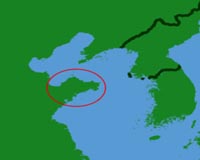
China Deploys Bomber Coverage Of Korea And Taiwan From Shandong Peninsula

The JH-7A fighter-bombers of China’s No. 5 Attacker Division deployed on the Shandong Peninsula theoretically could cover all the U.S. military bases in Korea and the Taiwan Strait.
They also could receive aerial support from the J-11 fighters deployed at the No. 19 Fighter Division at Jining in southwestern Shandong. Jining has the best military airport on the peninsula, where huge underground aircraft hangars and first-line maintenance and support facilities have been completed.
By contrast, the No. 12 Fighter Division, armed with J-8II fighters, has been somewhat neglected both in terms of construction at its airport and upgrading of its equipment. In terms of combat missions assigned to the two fighter divisions in this region, the No. 12 Division probably would be responsible for territorial air defense, while the No. 19 Division would be engaged in out-line operations along with the No. 5 Attacker Division.
In line with this trend of development, as well as the experiences of the No. 2 and No. 3 Fighter Divisions, the No. 19 Fighter Division may very likely receive more advanced combat aircraft in the future.
The Navy Aviation Force No. 5 Division also has been strengthened. This division is now equipped with new-generation J-8F fighters. The electronic reconnaissance and intelligence collection capabilities of the Navy Aviation Units under the People’s Liberation Army’s navy North Fleet have been fully enhanced over the years.
In recent years, there have been quite a number of occasions on which U.S. or Japanese fighters have intercepted Y-8 serial high-tech electronic reconnaissance and maritime patrol aircraft in the airspace above the East China Sea. The key base of the Y-8 serial reconnaissance aircraft is Laiyang, in the middle of the peninsula, the home base of the Independent Reconnaissance Regiment of the North Sea Fleet.
By extensively reinforcing the air force units stationed in Shandong, the PLA has naturally upgraded its air defense posture. The Shandong Peninsula has become another key area for the deployment of S-300 or HQ-9 surface-to-air missiles. So far, two S-300 or HQ-9 SAM positions have been located, currently under construction in Shandong. One is at a location close to Qingdao, which obviously is intended to provide protection for the headquarters of the North Sea Fleet and the No. 1 Nuclear Submarine Flotilla.
The other SAM position is located at Penglai, in northeastern Shandong. It is likely that the purpose of deploying S-300s or HQ-9s in this region is to provide protection for the nuclear power stations that are now in the planning stages. Shandong is planning to construct three nuclear power stations along 120 kilometers (about 75 miles) of coastline connecting three major cities — Qindao, Yantai and Weihai.
Of course, reinforcing air defense on the Shandong Peninsula will also enhance Beijing’s air defense posture. Some of the U.S. Air Force units stationed in Korea and Japan would have to cross the Shandong Peninsula in order to attack Beijing. The above two S-300 or HQ-9 SAM positions, both currently under construction, very likely will be put into use after receiving S-300PMU2 air defense systems.
Reinforcing Shandong’s air defense naturally will give nearby Henan province an effective air defense shield as well. Henan is the key strategic base of the PLA Second Artillery Force, with the mission of exerting strategic nuclear deterrence against the United States.
Also, some unconfirmed source says that a DF-31 long-range strategic missile (ICBM) brigade of the No. 52 Group Army is based at Laiwu in central Shandong province. China’s immense efforts to reinforce Shandong’s long-range air defense system seem to have special significance.

